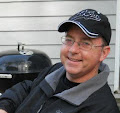Last fall, I decided to move to the next step in DCC - computer control. I purchased the RR-CirKits LocoBuffer-USB from Alex of DCCTrain at the Cincinatti NMRA Div 7 train show. The LocoBuffer-USB allows me to connect a computer to the Digitrax LocoNet - the wiring that connects all the throttle panels and the command station/booster which is the DB-150. I brought it home, read the simple 6 page manual and put it in a drawer. I was not quite ready to tackle this.
In the meantime, I downloaded JMRI: Java Model Railroad Interface open source software which has DecoderPro and PanelPro. The first application allows you to program the DCC decoders in the locomotives (as well as other decoders if I had them) and PanelPro enables you to create a simulated Dispatcher's panel which is really cool if you have blobk occupany detectors and motorized switches - I don't!
Anyway, I read through some of the documentation and experimented with it but it was not clicking how exactly it worked.
This week, I was able to take Lisa's old laptop computer and connect it to the LocoNet with the LocoBuffer-USB. I installed JMRI and tried programming one of the locomotives. One disappointment is that I can't read the current configuration from the decoder but that is a limitation of the DB-150 and not the software or connection. I would need to upgrade to the DCS-100 Command Station and that is not cheap! But, I can program the decoders a whole lot easier with the computer interface than through the UT-402 throttles. I was expecting some sort of ... boom ... moment but nothing.
Curious, I opened the DecoderPro throttle panel. Hmmnm. Looks like a software version of the handheld throttle. I increased the throttle from 0 to 10%. Is that the motor I hear? The locomotive was not moving. I moved it to 15%. Still not moving. I know I can hear the motor. Ok let's try ... oops! Engine 7046 definitely moved when I slipped and pegged the throttle at 100%. As it pushed the train through the switch that was thrown against it, derailing the cabin car and all 5 freight cars, I discovered that controlling the soft throttle with a mouse is a whole lot harder than the UT-402.
But this is going to be fun!!!
 |
| Engine 7046 throttle panel from JMRI - notice the LocoBuffer-USB on the shelf to the right |

No comments:
Post a Comment